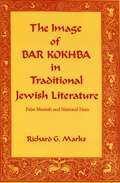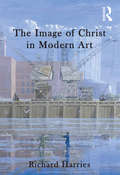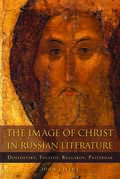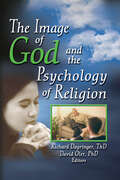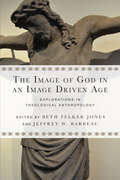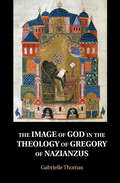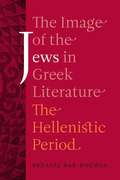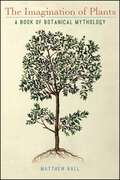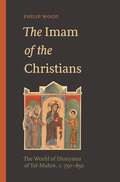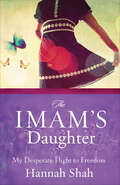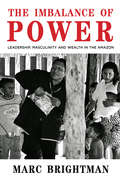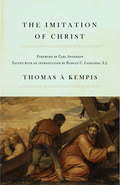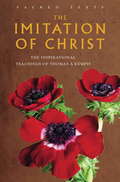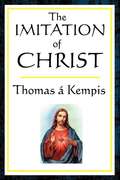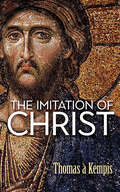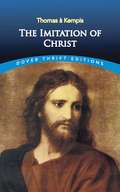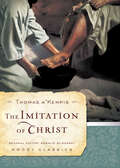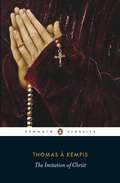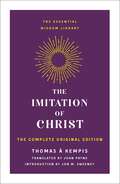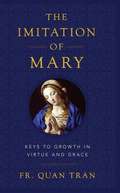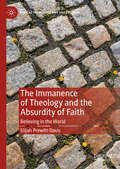- Table View
- List View
The Image of Bar Kokhba in Traditional Jewish Literature: False Messiah and National Hero (Hermeneutics: Studies in the History of Religions)
by Richard G. MarksBar Kokhba led the Jewish rebellion against Rome in 132–135 A.D., which resulted in massive destruction and dislocation of the Jewish populace of Judea. In early rabbinic literature, Bar Kokhba was remembered in two ways: as an imposter claiming to be the Messiah and as a glorious military leader whose successes led Rabbi Akiba, one of the great rabbinic authorities of Jewish tradition, to acclaim him the Messiah. These two earliest images formed the core of most later perceptions of Bar Kokhba, so that he became the prototypical false messiah and the paradigmatic rebel of Jewish history.The Image of Bar Kokhba in Traditional Jewish Literature is a history of the perceptions that later Jewish writers living in the fourth through seventeenth centuries formed of this legendary hero-villain whose actions, in their eyes, had caused enormous suffering and disappointed messianic hopes. Richard Marks examines each writer's account individually and in the context of its period, exploring particularly political and religious implications. He builds a history of images and looks at larger patterns, such as the desacralizing of traditional imagery. His findings raise timely political questions about Bar Kokhba's image among Jews today.
The Image of Christ in Modern Art
by Richard HarriesThe Image of Christ in Modern Art explores the challenges presented by the radical and rapid changes of artistic style in the 20th century to artists who wished to relate to traditional Christian imagery. In the 1930s David Jones said that he and his contemporaries were acutely conscious of ’the break’, by which he meant the fragmentation and loss of a once widely shared Christian narrative and set of images. In this highly illustrated book, Richard Harries looks at some of the artists associated with the birth of modernism such as Epstein and Rouault as well as those with a highly distinctive understanding of religion such as Chagall and Stanley Spencer. He discusses the revival of confidence associated with the rebuilding of Coventry Cathedral after World War II and the commissioning of work by artists like Henry Moore, Graham Sutherland and John Piper before looking at the very testing last quarter of the 20th century. He shows how here, and even more in our own time, fresh and important visual interpretations of Christ have been created both by well known and less well known artists. In conclusion he suggests that the modern movement in art has turned out to be a friend, not a foe of Christian art.Through a wide and beautiful range of images and insightful text, Harries explores the continuing challenge, present from the beginning of Christian art, as to how that which is visual can in some way indicate the transcendent.
The Image of Christ in Russian Literature: Dostoevsky, Tolstoy, Bulgakov, Pasternak (NIU Series in Slavic, East European, and Eurasian Studies)
by John GivensVladimir Nabokov complained about the number of Dostoevsky's characters "sinning their way to Jesus." In truth, Christ is an elusive figure not only in Dostoevsky's novels, but in Russian literature as a whole. The rise of the historical critical method of biblical criticism in the nineteenth century and the growth of secularism it stimulated made an earnest affirmation of Jesus in literature highly problematic. If they affirmed Jesus too directly, writers paradoxically risked diminishing him, either by deploying faith explanations that no longer persuade in an age of skepticism or by reducing Christ to a mere argument in an ideological dispute. The writers at the heart of this study understood that to reimage Christ for their age, they had to make him known through indirect, even negative ways, lest what they say about him be mistaken for cliché, doctrine, or naïve apologetics. The Christology of Dostoevsky, Leo Tolstoy, Mikhail Bulgakov, and Boris Pasternak is thus apophatic because they deploy negative formulations (saying what God is not) in their writings about Jesus. Professions of atheism in Dostoevsky and Tolstoy's non-divine Jesus are but separate negative paths toward truer discernment of Christ. This first study in English of the image of Christ in Russian literature highlights the importance of apophaticism as a theological practice and a literary method in understanding the Russian Christ. It also emphasizes the importance of skepticism in Russian literary attitudes toward Jesus on the part of writers whose private crucibles of doubt produced some of the most provocative and enduring images of Christ in world literature. This important study will appeal to scholars and students of Orthodox Christianity and Russian literature, as well as educated general readers interested in religion and nineteenth-century Russian novels.
The Image of God and the Psychology of Religion
by Richard L Dayringer David OlerWhat are the implications of a client&’s image of God?Improve your confidence-and your practice skills-by enhancing your knowledge of how individuals are likely to perceive God, and of how those perceptions impact the way they function as human beings. Theologians have long speculated and theorized about how humans imagine God to be. This book merges theology with science, presenting empirical research focused on perceptions of God in a variety of populations living in community and mental health settings. Each chapter concludes with references that comprise an essential reading list, and the book is generously enhanced with tables that make data easy to access and understand. "Liberating Images of God" discusses the constriction and impoverishment of God images due to the traditional restrictions of God images to those that are male and personified. This chapter examines the potential for the client and counselor&’s co-creation of images of God which embrace the feminine as well as the masculine, the nurturer as well as the warrior, and the natural world in all its dimensions as well as the human world, to liberate, enrich, sustain, and transform the client&’s relationships with God and with him/herself. "Attachment, Well-Being, and Religious Participation Among People with Severe Mental Disorders" examines the relationship between attachment states of mind and religious participation among people diagnosed with severe mental illness. "Concepts of God and Therapeutic Alliance Among People with Severe Mental Disorders" explores the transferential aspects of God representation among severely mentally ill adults. It highlights research on the relationship between a patient&’s image of God and that patient&’s working relationship with his/her case manager, and discusses the implications for clinical practice of those findings. "The Subjective Experience of God" presents a theory about the psychological basis for the experience of God that argues that this experience is essentially a form of projection and as such is an internal event that does not exist independent of an individual&’s psyche. This chapter draws a distinction between faith in a particular belief-namely, faith in the existence of a loving, omnipotent God-and an attitude of faith, which is the basis for experiences of transcendence. "Relationship of Gender Role Identity and Attitudes" presents the results of a study in which nearly 300 Catholic attendees at three university Catholic centers completed the Bern Sex Role Inventory, the Attitudes Toward Women Scale, and the Perceptions of God Checklist. This chapter looks at images of God as masculine or feminine, and at the connection for people between the way they perceive God and the way they relate towards men and women. "Reflections on a Study in a Mental Hospital," brings you groundbreaking new research on perceptions of God in an inpatient population. This chapter examines the positive effects (as opposed to the negative effects previously portrayed by the psychological community) of religious belief and practice for residential care patients in a psychiatric hospital.
The Image of God in an Image Driven Age: Explorations in Theological Anthropology (Wheaton Theology Conference Series)
by Beth Felker Jones Jeffrey W. BarbeauThe Image of God in an Image Driven Agetheosis
The Image of God in the Theology of Gregory of Nazianzus
by Gabrielle ThomasGregory of Nazianzus, known best for his Christology and Trinitarian doctrine, presents an incomparable vision of the image of God. In this book, Gabrielle Thomas offers a close analysis of his writings and demonstrates how Nazianzen depicts both the nature and experience of the image of God throughout his corpus. She argues that Nazianzen's vision of the human person as an image of God is best understood in light of biblical and extra-biblical themes. To establish the breadth of his approach, Thomas analyzes the image of God against the backdrop of Nazianzen's beliefs about Christology, Pneumatology, creation, sin, spiritual warfare, ethics, and theosis. Interpreted accordingly, Nazianzen offers a dynamic and multifaceted account of the image of God, which has serious implications both for Cappadocian studies and contemporary theological anthropology.
The Image of the Jews in Greek Literature: The Hellenistic Period
by Bezalel Bar-KochvaExamining the attitudes of Hellenistic Greek authors and scholars toward the Jewish people, and their religion and customs, over a span of 270 years, this book focuses on twelve authors from whom we have fragments and testimonials referring to the Jews.
The Imagination of Plants: A Book of Botanical Mythology (SUNY series on Religion and the Environment)
by Matthew HallPlants have a remarkable mythology dating back thousands of years. From the ancient Greeks to contemporary Indigenous cultures, human beings have told colorful and enriching stories that have presented plants as sensitive, communicative, and intelligent. This book explores the myriad of plant tales from around the world and the groundbreaking ideas that underpin them. Amid the key themes of sentience and kinship, it connects the anemone to the meaning of human life, tree hugging to the sacred basil of India, and plant intelligence with the Finnish epic The Kalevala. Bringing together commentary, original source material, and colorful illustrations, Matthew Hall challenges our perspective on these myths, the plants they feature, and the human beings that narrate them.
The Imam of the Christians: The World of Dionysius of Tel-Mahre, c. 750–850
by Philip WoodHow Christian leaders adapted the governmental practices and political thought of their Muslim rulers in the Abbasid caliphateThe Imam of the Christians examines how Christian leaders adopted and adapted the political practices and ideas of their Muslim rulers between 750 and 850 in the Abbasid caliphate in the Jazira (modern eastern Turkey and northern Syria). Focusing on the writings of Dionysius of Tel-Mahre, the patriarch of the Jacobite church, Philip Wood describes how this encounter produced an Islamicate Christianity that differed from the Christianities of Byzantium and western Europe in far more than just theology. In doing so, Wood opens a new window on the world of early Islam and Muslims’ interactions with other religious communities.Wood shows how Dionysius and other Christian clerics, by forging close ties with Muslim elites, were able to command greater power over their coreligionists, such as the right to issue canons regulating the lives of lay people, gather tithes, and use state troops to arrest opponents. In his writings, Dionysius advertises his ease in the courts of ʿAbd Allah ibn Tahir in Raqqa and the caliph al-Ma’mun in Baghdad, presenting himself as an effective advocate for the interests of his fellow Christians because of his knowledge of Arabic and his ability to redeploy Islamic ideas to his own advantage. Strikingly, Dionysius even claims that, like al-Ma’mun, he is an imam since he leads his people in prayer and rules them by popular consent.A wide-ranging examination of Middle Eastern Christian life during a critical period in the development of Islam, The Imam of the Christians is also a case study of the surprising workings of cultural and religious adaptation.
The Imam's Daughter: My Desperate Flight to Freedom
by Hannah ShahHannah Shah is an Imam's daughter. She lived the life of a devout Muslim in a family of Pakistani Muslims in England, but behind the front door, she was a caged butterfly.For many years, her father abused her in the cellar of their home. At sixteen, she discovered a plan to send her to Pakistan for an arranged marriage, and she gathered the courage to run away. Relentlessly hunted by her angry father and brothers, who were intent on executing an "honor" killing, she moved from house to house in perpetual fear to escape them. Over time, she converted to Christianity and was able to live and marry as she wished.Hannah found the courage to live her life free from shame, free from religious intolerance, and free from the abuse that haunted her childhood. This is a remarkable true story of how a young girl escaped a life of torture . . . a story you won't forget.
The Imbalance of Power: Leadership, Masculinity and Wealth in the Amazon
by Marc BrightmanAmerindian societies have an iconic status in classical political thought. For Montaigne, Hobbes, Locke, Hume and Rousseau, the native American ‘state of nature’ operates as a foil for the European polity. Challenging this tradition, The Imbalance of Power demonstrates ethnographically that the Carib speaking indigenous societies of the Guiana region of Amazonia do not fit conventional characterizations of ‘simple’ political units with ‘egalitarian’ political ideologies and ‘harmonious’ relationships with nature. Marc Brightman builds a persuasive and original theory of Amerindian politics: far from balanced and egalitarian, Carib societies are rife with tension and difference; but this imbalance conditions social dynamism and a distinctive mode of cohesion. The Imbalance of Power is based on the author’s fieldwork in partnership with Vanessa Grotti, who is working on a companion volume entitled Living with the Enemy: First Contacts and the Making of Christian Bodies in Amazonia.
The Imitation of Christ
by Thomas À Kempis Harold C. GardinerOnly the Bible has been more influential as a source of Christian devotional reading than The Imitation of Christ. This meditation on the spiritual life has inspired readers from Thomas More and St. Ignatius Loyola to Thomas Merton and Pope John Paul II. Written by the Augustinian monk Thomas à Kempis between 1420 and 1427, it contains clear instructions for renouncing worldly vanities and locating eternal truths. No book has more explicitly and movingly described the Christian ideal: "My son, to the degree that you can leave yourself behind, to that degree will you be able to enter into Me." With a new Foreword by Carl Anderson, the Supreme Knight and chief executive officer of the Knights of Columbus.
The Imitation of Christ
by Stephan MackennaThe saintly Thomas à Kempis's classic guide to the spiritual and religious life. A book which has been loved and revered by devout Christians throughout the ages. Transcending all sectarian divisions, it emphasises the importance of the inward journey.
The Imitation of Christ
by Stephan MackennaThe saintly Thomas à Kempis's classic guide to the spiritual and religious life. A book which has been loved and revered by devout Christians throughout the ages. Transcending all sectarian divisions, it emphasises the importance of the inward journey.
The Imitation of Christ
by Stephan MackennaThe saintly Thomas à Kempis's classic guide to the spiritual and religious life. A book which has been loved and revered by devout Christians throughout the ages. Transcending all sectarian divisions, it emphasises the importance of the inward journey.
The Imitation of Christ
by Thomas A. KempisThis classic, second only to the Bible for religious instruction and inspiration, has brought understanding and comfort to millions for centuries. Written in a candid and conversational style, the topics include liberation from worldly inclinations, preparation and consolations of prayer, and the place of eucharistic communion in a devout life.
The Imitation of Christ
by Thomas à KempisWritten by the pious monk Thomas á Kempis, this timeless masterpiece offers wisdom and hope by providing precepts we can use to draw nearer to God and learn how best to grow in holiness through obedience and love. In the realm of Christian devotional literature, this religious classic has illuminated countless souls over the ages, transcending the boundaries of denominations, beliefs, and the confines of time. Within these pages, a spiritual journey unfolds intimately in heartfelt prose, providing guidance in the resistance of worldly desires, the significance of mental recollection as a precursor to meditative prayer, and finding gratitude and strength in the soothing embrace of divine consolation and the sacred rite of Eucharistic communion. One of the most influential works in Christian literature, the book is an excellent resource for historians, mystics, and those seeking private devotion.
The Imitation of Christ (Dover Thrift Editions Ser.)
by Thomas À Kempis Harold Bolton Aloysius CroftThis classic of Christian devotional literature has brought understanding and comfort to millions for centuries. Both Protestants and Catholics — as well as mystics and historians of religious thought — have studied these meditations on the life and teachings of Jesus, finding in them a path to prayer and spiritual guidance. Written in a candid and conversational style, The Imitation of Christ discusses liberation from worldly inclinations, recollection as a preparation for prayer, the consolations of prayer, and the place of eucharistic communion in a devout life. With its simple, readable text, this translation will appeal to new readers as well as to those already familiar with this religious classic.
The Imitation of Christ (Moody Classics)
by Thomas A'KempisThomas a Kempis was not a haphazard follower of Jesus. The depth of his masterpiece mirrors the life of a man who did whatever was necessary to imitate his own Savior. A Kempis lived as intentionally as he wrote. We must turn away from the things of this world, we must live sacrificially, we must be inundated with Christ's passionate teaching, and we must pray to be removed from distraction.A classic in every state of the word, The Imitation of Christ places the fruit of one man's single-minded devotion to God's calling on his life within the reach of every reader. May we all commit to be this effective in our emulation of Jesus. Moody ClassicsOf all the factors influencing our spiritual growth and development, pivotal books play a key role. Learning from those who have walked the path and fought the fight brings wisdom and strengthens resolve. And hearing the familiar chords of kingdom living sung by voices from other times can penetrate cultural barriers that limit our allegiance to the King. To this end, Moody Publishers is honored to introduce the first six volumes in what is to be an ongoing series of spiritual classics. Selected for their enduring influence and timeless perspective, these new editions promise to shape the lives of spiritual pilgrims for generations to come.
The Imitation of Christ (Moody Classics)
by Thomas A'KempisThomas a Kempis was not a haphazard follower of Jesus. The depth of his masterpiece mirrors the life of a man who did whatever was necessary to imitate his own Savior. A Kempis lived as intentionally as he wrote. We must turn away from the things of this world, we must live sacrificially, we must be inundated with Christ's passionate teaching, and we must pray to be removed from distraction.A classic in every state of the word, The Imitation of Christ places the fruit of one man's single-minded devotion to God's calling on his life within the reach of every reader. May we all commit to be this effective in our emulation of Jesus. Moody ClassicsOf all the factors influencing our spiritual growth and development, pivotal books play a key role. Learning from those who have walked the path and fought the fight brings wisdom and strengthens resolve. And hearing the familiar chords of kingdom living sung by voices from other times can penetrate cultural barriers that limit our allegiance to the King. To this end, Moody Publishers is honored to introduce the first six volumes in what is to be an ongoing series of spiritual classics. Selected for their enduring influence and timeless perspective, these new editions promise to shape the lives of spiritual pilgrims for generations to come.
The Imitation of Christ (The\five Foot Shelf Of Classics Ser.)
by Thomas à KempisOne of the most influential and well-loved books of Christianity, The Imitation of Christ by Thomas à Kempis appears here in Penguin Classics in a new translation by Robert Jeffery, with an introduction by Max Von Habsburg, notes, a chronology and further reading.The Imitation of Christ is a passionate celebration of God's love, mercy and holiness, which has stimulated religious devotion for over five hundred years. With great personal conviction and deep humanity, Thomas à Kempis (1380-1471) demonstrates the individual's reliance on God and on the words of Christ, and the futility of a life without faith, as well as exploring the ideas such as humility, compassion, patience and tolerance. Thomas spent some seventy years of his life in the reclusive environment of monasteries, yet in this astonishing work he demonstrates an encompassing understanding of human nature, while his writing speaks to readers of every age and every nation.Thomas à Kempis was born at Kempen near Dusseldorf in 1380. He received the priesthood in 1413. Thomas wrote many other devotional works besides The Imitation of Christ, his masterpiece, as well as biographies of Gerald Groote and Florentius Radewyn. He died in 1471.The Very Revd Robert Jeffery was born in 1935 and ordained in 1959. He has written on matters of Church history, spirituality, mission and ecumenism. In 1978, he became Archdeacon of Salop, and was Dean of Worcester from 1987-96 and subsequently Canon and Sub-Dean of Christ Church, Oxford. He retired in 2002 and is an Hon Doctor of Divinity of Birmingham University.Max von Habsburg is the author of Catholic and Protestant Translations of the Imitatio Christi 1425-1650 (2011).
The Imitation of Christ: The Complete Original Edition (The Essential Wisdom Library)
by Thomas à KempisThomas à Kempis's The Imitation of Christ is a timeless devotional guide calling readers to a Christlike life, featuring an introduction by Jon M. Sweeney.One of the most beloved Christian devotionals, The Imitation of Christ was originally written in Latin during the fifteenth century and inspired countless readers to deepen their faith and build a stronger relationship with Christ. Kempis was focused on the contemplative, inner life and his work has been a trusted guide for generations of Christians in their own walks of faith.In the first two sections of the book, Kempis reflects on the spiritual and interior life, offering wisdom for those seeking to begin their own journey of reflection and contemplation. The final section of the book focuses on two imagined dialogues between Jesus and an unnamed disciple, which illuminate the totality of God’s love and grace.The Imitation of Christ is part of the Essential Wisdom Library, a series of books that seeks to bring spiritual wisdom—both modern and ancient—to today’s readers. This new edition of the classic text is a must read for seekers and believers alike.
The Imitation of Mary: How to Grow in Virtue and Merit God's Grace
by Quan D. TranIn this book, the author shows how to imitate the twelve essential qualities of Mary in order to unleash a torrent of graces in life. He explains that, like any gift, grace must be received, opened, and used. As you learn how, you'll begin to acquire the temperaments, dispositions, and qualities that are most pleasing to God, and you'll serve as a channel of God's grace for others.
The Immanence of Theology and the Absurdity of Faith: Believing in the World (Radical Theologies and Philosophies)
by Elijah Prewitt-DavisThe constant inundation of the affect and information experienced by contemporary individuals exposes the tragic nature of the world, making nihilism an epistemologically reasonable response. To counter the threat of nihilism, Elijiah Prewitt-Davis argues that knowledge must be replaced by belief. Against the common protestant concept of belief as strictly personal and interior, he proposes believing in the world as an absurd and immanent faith in the impossible—a belief that allows one to see and feel the potentialities simmering within the world as it is. Following Gilles Deleuze call to “transform belief,” Prewitt-Davis explores how belief heightens an affective attachment to our embeddedness on the world, revealing the potentialities with which time is always pregnant. Believing in the world as it is paradoxically becomes the mode of transforming the world inasmuch as the potential for something impossibly new is always immanently present.
